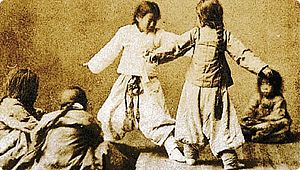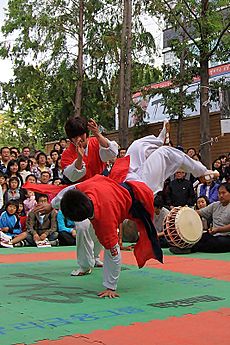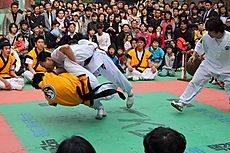Taekkyeon facts for kids
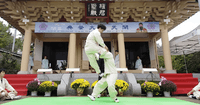
Taekkyon Demonstration on National Foundation Day 2017 at Sajikdan, Seoul
|
|
| Also known as | Taekgyeon, Taekkyeon |
|---|---|
| Focus | Self-defense with a focus on kicks, trips, throws in competitions |
| Hardness | Full contact |
| Country of origin | Korea |
| Parenthood | Subak |
| Official website | Four associations |
| Taekkyeon | |
|---|---|
|
UNESCO Intangible Cultural Heritage
|
| Popular spelling | |
| Hangul | |
|---|---|
| Revised Romanization | Taekgyeon |
| McCune–Reischauer | T'aekkyŏn |
| IPA | tʰɛk̚k̕jʌn |
| Dictionary spelling | |
| Hangul | |
| Revised Romanization | Taekkyeon |
| McCune–Reischauer | T'aekkyŏn |
Taekkyon (Korean: 태껸/ 택견, pronounced tʰɛk̚k̕jʌn) is a traditional Korean martial art. It is known for its smooth, flowing foot movements. These movements are called "pum balgi" or "Stepping-on-Triangles."
In Taekkyon, people use both their hands and feet together. The goal is to make an opponent lose balance, trip them, or throw them down. A person who practices Taekkyon is called a "Taekkyon-kkun" (태껸꾼). They usually wear a traditional Korean uniform called "hanbok."
Taekkyon is seen as an important link to Korea's past. Many people consider it one of Korea's oldest martial arts. It was the first martial art to be listed as a UNESCO Intangible Cultural Heritage. It is also the 76th Intangible Cultural Property of South Korea.
Contents
The History of Taekkyon
Records about Taekkyon are not very detailed. The word first appeared during the Joseon Dynasty (1392–1897). It was in a book called Jaemulbo, written by Lee Sung-Ji around 1776–1800. The book said: "Byeon and Subak are Byeon, Gangnyeok is Mu and all these are called Tak-gyeon." The word "Tak-gyeon" was written in Hangul, showing it was used by common people.
Song Deok-gi (1893–1987) was very important for keeping Taekkyon alive. He wrote that no one knows exactly when Taekkyon started. But people practiced it until the end of the Korean kingdom.
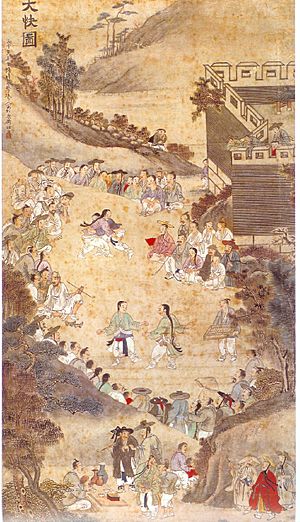
In 1895, Taekkyon was first written about in the West by Stewart Culin. In 1921, a book called "Haedong Jukji" described Taekkyon as "flying leg technique."
Taekkyon was very popular during the Joseon period. There were two ways to practice it: one for fighting and one as a game. The game version was popular among ordinary people, often played with Ssireum (Korean wrestling). These sports were often part of festivals.
However, Taekkyon became less popular as Neo-Confucianism grew among the rich. By the early 1900s, it was only practiced around Seoul. The Japanese occupation (1910-1945) made it illegal to practice Korean fighting styles. This almost made Taekkyon disappear.
After the Korean War (1950-1953), only one master, Song Deok-gi, remained. He had secretly practiced Taekkyon during the Japanese rule. He helped bring the art back to life. The style he practiced was called Widae. Song Deok-gi shared his knowledge, and most of what we know about Taekkyon today comes from him.
On June 1, 1983, the Korean government named Taekkyon an "Important Intangible Cultural Asset No. 76." Song Deok-gi was then called a "national treasure." Since then, Taekkyon has become popular again. New schools and university clubs have opened. In November 2011, UNESCO added Taekkyon to its Intangible Cultural Heritage List. It was the first martial art to receive this honor.
Taekkyon Techniques
Taekkyon uses many different moves. These include kicks, punches, knee and elbow strikes, and throws. It also uses joint locks and grappling. Every movement uses the whole body.
The most special part of Taekkyon is its triangular footwork called pumbalkki (품밟기). It looks like a dance. The word "pum" refers to the shape of the Chinese character 品, which looks like a triangle.
Modern Taekkyon schools teach many kinds of kicks. These include low, medium, and high kicks, as well as jumps. There are sweeps with low kicks and high crescent-like kicks. The art also uses tricks like trips, wall-jumping, and fake-outs. All movements are natural for the human body.
Taekkyon movements are smooth, and practitioners are always moving. A key feature is gumsil or ogeum jil. This is a constant bending and straightening of the knees. It makes the art look like a dance. This movement is also used in Korean mask dances.
Even though Taekkyon mainly uses kicks and strikes, it also includes many throws and grappling techniques. This helps to complete its focus on striking.
Taekkyon has forms that change and grow. One form can be done in many ways. Masters can also create their own ways to teach the basic Taekkyon system.
Taekkyon as a Sport

When Taekkyon is played as a sport, it uses fewer techniques. It focuses only on grappling and kicking. You score points by throwing your opponent to the ground. You can also score by pushing them out of the ring or kicking them in the head.
Hand strikes and headbutts are not allowed. It is also against the rules to try and hurt your opponent on purpose. Head kicks are often quick but usually not full force. Fighters do not try to wear down their opponent with body blows.
Matches are sometimes decided by who scores two points first. Different schools might have slightly different rules. To someone watching for the first time, the matches look careful but exciting. The players move around each other, constantly changing their footwork. They use pumbalkki and fake low kicks. Then, they might suddenly burst into action, which could end with one fighter on their back.
Modern Taekkyon Groups
Today, several Taekkyon groups exist in Korea and around the world:
- The Widae Taekkyon Preservation Society (WWTO): This group is based in Seoul and Los Angeles. It was started by Song Deok-gi and Lee Jun-seo in 1983.
- The Korea Traditional Taekgyeon Association (KTTA): This group is based in Chungju. It helped Taekkyon become recognized as a UNESCO Intangible Cultural Heritage.
- The Korea Taekkyon Federation (KTF): Based in Busan, this is the largest Taekkyon group. It was started in 1991. This group helped shape how people see Taekkyon today, as a non-violent folk game with kicks.
- The Kyulyun Taekyun Association (KTK): Based in Seoul, this group was started in 2000. It is known for holding the "Taekyun Battle" tournament each year.
Taekkyon is also practiced in many other countries. These include Australia, China, France, Germany, Japan, and the USA.
Taekkyon in Pop Culture
Taekkyon has appeared in many comics, movies, and video games.
Comics
- The God of High School: A webtoon where characters use "Ssam Ryu Taekkyon."
- Bridal Mask: A manhwa (Korean comic) where the main character uses Taekkyon against Japanese rulers.
Movies
- Fighter in the Wind: A movie about a karate master. It shows him practicing Taekkyon.
- Show down: A martial arts film where different fighters challenge each other.
- The three kims: A comedy where a character uses Taekkyon against gangsters.
Video Game
- League of Legends: A popular online game. The character Lee Sin uses moves from different martial arts, including Taekkyon.
Television Series
- Warrior (TV series): In one episode, a Korean fighter uses Taekkyon.
See also
 In Spanish: Taekkyon para niños
In Spanish: Taekkyon para niños


